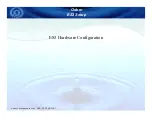
100
ELITechGroup employs an OG stain as in the traditional papanicolaou stain. The OG stain is filtered using
an 0.2 µM filter to eliminate any precipitates.
4. Alcohol Wash
The traditional papanicolaou stain procedure employs a graded alcohol series of 50, 75, 95%, for washing
and dehydration. This has been shown to be unnecessary
(12)
. Dunton recommends anhydrous isopropanol,
as it has a lower capacity to destain the smear during washing. Normally ethanol is employed.
Reagent E provides a better destaining action for cells and also for the nozzles and carousel during the
Clean Cycle and is more miscible than ethanol in most mountant media.
5. EA-50 Stain
The ELITechGroup EA stain is an alcoholic solution of Eosin Y and fast green or light green SF.
Phosphotungstic acid and acetic acid are employed to enhance the binding of the green component. The
solution is designed to provide staining comparable to other commercial EA stains. Bismarck brown is
omitted as previously discussed.
The Aerospray stainer provides 9 settings which alter the amount of stain applied and the time of staining.
Since the differentiation between cells is at least partially based on staining rate, it is affected by the
setting employed. The short setting provides little staining by fast green (or light green). As the stain
setting is increased, the green predominates, and the smear becomes darker and bluer. The modification
of the staining balance, however, is somewhat limited using the settings alone. Greater alterations
require modification of the staining solutions. When used without modification, the stain yields a turquoise
intermediate cell and pink-to-red superficial cells. This can be modified as described by Boon and
Drijver
(5,6)
. Raising the pH enhances the blue color and lowering the pH shifts the color to green.
6. Acid Alcohol Wash
The Acid Alcohol Wash is designed to clean and maintain the Hematoxylin Reagent D line.
7. Clearing and Mounting
The traditional method of clearing is to replace residual alcohol with an aromatic hydrocarbon (commonly
toluene or xylene). The Aerospray Cytology employs a centrifugal clearing to remove excess reagents.
This allows alternative clearing solvents (such as Formula 83), free of the toxicities associated with
hydrocarbons, to be used. Other organic solvents may also be used, Drijver and Boon prefer t-butanol
(18)
.
The Aerospray Cytology avoids the need for xylene use by washing the slides with fresh anhydrous alcohol
coupled with centrifugal clearing. However, xylene or toluene may offer an advantage in certain high
humidity environments.
References
1. G.N. Papanicolaou, Some Improved Methods for Staining Vaginal Smears. J. Lab. Clin. Med., 26,
1200-1205 (1941).
2. G.N. Papanicolaou, A New Procedure for Staining Vaginal Smears. Science, 95, 438-439 (1942).
3. G. N. Papanicolaou, and H.F. Traut, Diagnosis of Uterine Cancer by the Vaginal Smear. The
Commonwealth Fund, New York (1943).
4. P.N. Marshall, Papanicolaou Staining - a Review. Microscopica Acta, 87(3), 233-243 (1983).
5. J.S. Drijver and M.E. Boon, Manipulating the Papanicolaou Stain: Role of acidity in the EA
counterstain. Acta Cytologica, 27(6), 693-698 (1983)
6. M.E. Boon and J.S. Drijver, Routine Cytological Staining Techniques. Elsevier, N.Y., (1986).
7.
H. Puchtler, and H. Isler, The Effect of Phosphomolybdic Acid on Stainability of Connective Tissue by
Various Dyes. J. Histochem and Cytochem., 6 265-270 (1958).
8.
S.L. Pharr, D.A. Wood, H.F. Traut, A Simplified Method of Preparing EA and Orange G Stains. Am. J.
Clin Pathol., 24, 239-242 (1954).
Appendix F: Technical Background of Papanicolaou Staining



































